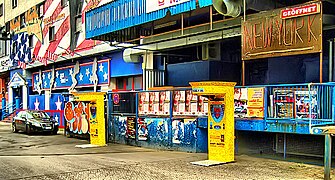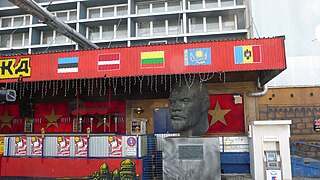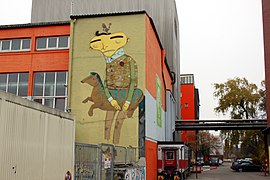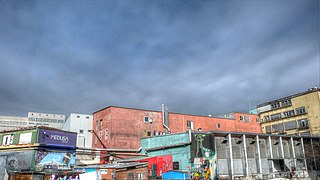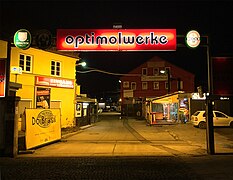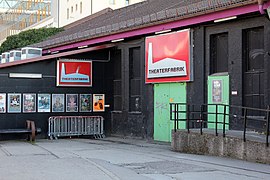Cult factory
The Kultfabrik was a culture and event center opened on April 11, 2003 in Munich and the successor to the Kunstpark Ost . The center was closed in 2016 and largely demolished by summer 2017 as part of an urban development project. There are still a few discos on the site, which is now part of the newly emerging Werksviertel . The clubs on the neighboring Optimolwerke site were closed at the beginning of 2018.
Art Park East (KPO)
The Kunstpark Ost was a 90,000 m² leisure area and event center on a former factory site in the Berg am Laim district of Munich directly at the Ostbahnhof , which existed from September 1996 to January 31, 2003.
In 1996 the food manufacturer Pfanni relocated production from its Munich headquarters to Mecklenburg-Western Pomerania. The vacant factory site was leased to the Munich entrepreneur Wolfgang Nöth , who set up an entertainment area there. Nöth had already gained experience with a similar project on the grounds of Munich-Riem Airport , which was abandoned in 1992 , but which had to give way to the new trade fair city of Riem .
In September 1996, around 30 discos (for example the Babylon, Ultraschall , KW - Das Heizkraftwerk , Natraj Temple and K 41), clubs (for example the Cohibar), bars, restaurants, arcades and around 60 artist studios took place on the site of the former Pfanni factory and 30 small businesses to operate. Concerts and art and antique flea markets were also held at regular intervals. Not least because of the convenient location at Munich East train station , the area attracted numerous visitors, especially on the weekends. 250,000 people per month, around half of them from the greater Munich area, were the norm for years.
Despite the name, Kunstpark Ost was always designed as a commercial enterprise. Accordingly, criticism of the Kunstpark Ost often referred to the profit-oriented as opposed to the implicit subcultural orientation.
On January 31, 2003 the Kunstpark Ost was dissolved. Some clubs migrated and looked for new halls such as For example, the Babylon, which moved to the Elserhallen in the neighborhood, others stayed where they were, and the area of the old KPO is now called Kultfabrik. The Optimol factories were built in the immediate vicinity.
successor
Cult factory
The cult factory was located on Grafinger Strasse on the site of the former Pfanni works. It comprised more than 25 clubs, discos, bars, concert halls and various event locations and was therefore the starting point for all kinds of music. The area of the cult factory at the time was 90,000 square meters in size and, in addition to the clubs and discos, was home to over 100 commercial tenants, the whiteBOX art hall, several theater halls, the TonHalle concert and event hall, Europe's highest indoor climbing hall Heavens Gate, a 2,000 square meter city beach, Various commercial establishments, visual artists, band and rehearsal rooms, the Kulti-Kids children's experience power plant, which is run by the Kulti-Kids eV association, as well as snack bars, small businesses and shops. A total of around 1,700 people worked on the site.
The well-known clubs and venues of the Kultfabrik included: Tonhalle, Kantine, Natraj Temple, Octagon, New York Table Dance, Strobe Club, 11er, Americanos, Die Bar, Eddy's Rockclub, Herzglut, Kölsch Bar, La Dolce Vita, Latino's Bar & Club, Living4, Mondscheinbar, Mr. Wong, Nachtfee, Nox Club Munich, Pub Crawl Munich, Rafael, Roses, Schlagergarten, The Temple Bar, Titty Twister and Willenlos. Some of them already existed in the Kunstpark Ost.
In the heart of the Kultfabrik was the canteen, which, depending on the time of day and the occasion, can be transformed into a spacious café, restaurant or nightlife bar. The canteen is one of the few restaurants in Munich that is also open at night: night owls can eat and drink here until 5 a.m. In addition to burgers and fries, the menu also includes a variety of Mediterranean dishes, pasta, wood-fired pizzas and home-style cooking. Even in the days of Kunstpark Ost, the canteen - under its name Nachtkantine at the time - was a well-known and popular meeting point, which, in addition to dishes and cocktails, also had changing DJ evenings on the program. And the canteen can look back on even more. The name canteen, for example, is no coincidence: from 1969 to 1996 what is now the trendy canteen of the Pfanni company served as the company canteen. At that time, the company canteen served up to 1200 employees a day.
In spring 2004, the whiteBOX exhibition site (former Plant 3 of the Pfanni factory) with an area of 1000 square meters was opened in the western part of the site. The exhibition All about pillows kicked off . The pillow art show was shown before in Milan, and after the Munich exhibition in Paris. Among the 180 works by international artists there were also those by Yoko Ono , Ugo Dossi and Andrea Contin . The whiteBOX, which extends over two floors, has been operated by the non-profit art association of the same name since December 2005. Thanks to its many national and international exhibitions and performances in Munich, the Kunsthalle has become a highly regarded art location.
The Kulti-Kids experience power plant, which is operated by the non-profit association of the same name, has been located in the former Pfanni-Werke thermal power plant since 2004, where the Kraftwerk techno club was previously located. The hall, which is equipped with a slide course and various play attractions, offers children and young people plenty of space to play and run around on three levels and is open to open play on weekends. During the week, a wide range of leisure activities (TRAU DICH children's circus, active crawling group, early musical education, etc.) invites children and their parents to do sports, do handicrafts and other activities. Private children's birthdays can also be celebrated there.
Hall 7 with its permanent venues darkBOX and duschBOX has been on the site since the beginning of 2007. The concept of Halle7: Actors and stage artists from the field of performing arts should have the opportunity to continue working in their profession even during a phase of non-regular employment. The productions in Halle7, including many world premieres by young authors from German-speaking countries, always arouse lively media interest, regionally and nationally.
The Potato Museum is also located on the Kultfabrik site . The facility established by the Otto Eckart Foundation was opened in 1996. The Potato Museum shows a multifaceted collection of exhibits related to potatoes and is the only museum in the world that is exclusively devoted to the potato in terms of art and art history and has a large specialist library. In 2006 the Potato Museum was expanded to include the Pfanni Museum. In 2011 the Potato Museum made an extraordinary contribution to the Blue Year by dedicating a year-round exhibition to the blue potato.
- gallery
Thermal power station ( power station , Kulti-Kids)
Potato drying system ( ultrasound , octagon, NOx)
Optimolwerke
The former management of the Art Park East opened a further, smaller area especially for discos and clubs under the name Optimolwerke on the former company premises of the same name of the Optimol Ölwerke , which existed until the beginning of 2018. Its entrance was in the south-western part of Friedenstrasse.
The Optimolwerke accommodated the techno clubs Harry Klein , Bullitt Club, Cheshire Cat and Storchenburg & Alte Raffinerie, the clubs Milchbar, Tante Erna, Keller, Do Brasil, Katz & Maus, Kuhstall, Club Movida, Club Duo (merged by Club 4 and Choice Club), The Castle, the Spiegelzelt and the Theaterfabrik concert and event hall . At first the two areas were connected by a path. However, this connection was cordoned off in order to make it difficult for guests of the respective premises to change. Two prominent Optimolwerke clubs - Harry Klein and the Milchbar - left the premises in June 2010 and April 2013 and moved to Munich city center ( Sonnenstrasse ).
In March 2017, the Berg am Laim district committee spoke out against an extension of the club operator's licenses. The last parties took place in the clubs of the Optimolwerke on the night of January 13-14, 2018. The former factory site was then completely demolished by September 2018.
- gallery
The Bullitt Club in old Harry Klein
Future of the area
In 2016, the demolition and renovation of part of the former Pfanni- and Kunstpark grounds began in favor of office and residential buildings in the future Munich factory district .
See also
literature
- Art Park East Munich (PDF; 10.1 MB) in Martina Baum: Urban Places Part II , Universitätsverlag Karlsruhe, 2008, ISBN 978-3-86644-286-3 .
Web links
swell
- ↑ Boom-Boom on Sonnenstrasse www.sueddeutsche.de, November 21, 2007
- ↑ How the milk bar got its name www.sueddeutsche.de, April 13, 2013
- ^ Dance around the party zones www.sueddeutsche.de, May 11, 2010
- ↑ Optimolwerke: No extension for the clubs. In: tz Munich . March 13, 2017. Retrieved March 8, 2017 .
- ↑ Philipp Crone: The Optimol works are really celebrating the last time. www.sueddeutsche.de, December 28, 2017, accessed on January 18, 2018 .
- ↑ Thomas Becker: The last party "Half the club was crying". www.sueddeutsche.de, January 14, 2018, accessed on January 18, 2018 .
Coordinates: 48 ° 7 ′ 26 ″ N , 11 ° 36 ′ 29 ″ E



